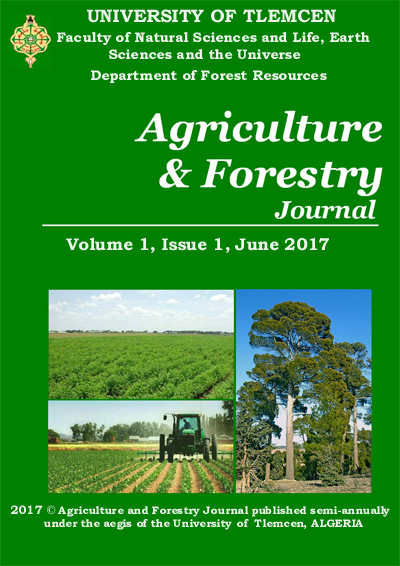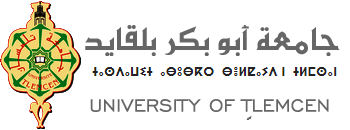Application of hydrological indices and GIS for the spatial detection of areas at risk of erosion. Case of the watershed of Oued Rhumel, East Algeria
DOI:
https://doi.org/10.46325/afj.v8i1.157Abstract
In Algeria, the loss of water capacity in reservoirs is a major challenge in the face of a significant increase in water demand. This loss of resources is due to the sedimentation of reservoirs, one of the most serious consequences of erosion. The use of hydrological indices is widely recognized as a highly effective method of providing input data for the cartographic representation of prone-to-erosion areas within geographic information systems. In the present study, the hydrological indices essential for erosion modeling were obtained through meticulous processing and analysis of a digital elevation model. The various indices, including the sediment transport index, composite topographic index, and stream power index, were combined with other relevant variables such as slope, curvature, channel spacing, and channel density. The results of the survey showed that a significant part of the Oued Rhumel watershed, located in the eastern region of Algeria, specifically 24.35% or 1,292.72 km2, is located in an extremely high or high erosion zone, which requires the immediate implementation of conservation measures. In addition, a total of 190.81 km2 or 2,024.47 km2 is located in areas with a moderate or low risk of erosion, respectively. It is therefore evident that the use of primary and secondary derivatives of the digital elevation model, as well as morphometric parameters, through the application of a spatial analysis tool, is an effective and comprehensive method for identifying erosion-sensitive zones. This approach can be used on a regional or continental scale to facilitate watershed management and monitoring.
Keywords : Erosion, Stream power index, Topographic wetness index, Erosion modeling, Oued Rhumel watershed.
References
Ahmad I., Dar M A., Teka A H., Gebre T., Gadissa E., Tolosa A T., 2019. Application of hydrological indices for erosion hazard mapping using Spatial Analyst tool. Environmental monitoring and assessment, 191(8): 482.
Bannari A., El-Battay A., Hameid N., Tashtoush F., 2017. Salt-affected soil mapping in an arid environment using semiempirical model and Landsat-OLI data. Advances in Remote Sensing, 6(4): 260-291
Buitrago J Y., Martínez L J., 2016. Digital elevation models (DEM) used to assess soil erosion risks: a case study in Boyaca, Colombia. Agronomía Colombiana, 34(2): 239-249
Chang K T., Tsai B W., 1991. The effect of DEM resolution on slope and aspect mapping. Cartography and geographic information systems, 18(1): 69-77.
Daly E., Porporato A., 2005. A review of soil moisture dynamics: from rainfall infiltration to ecosystem response. Environmental engineering science, 22(1): 9-24
Daniel A., Getachew W., 2019. Quantitative analysis of mor-phometry on Ribb and Gumara watersheds: implications forsoil and water conservation. International Soil and Water Conservation Research, (7):150–157.
Dietrich W E., Wilson C J., Montgomery D R., McKean J., 1993. Analysis of erosion thresholds, channel networks, and landscape morphology using a digital terrain model. The Journal of Geology, 101(2): 259-278.
Dymond J R., Harmsworth G R., 1994. Towards automated land resource mapping using digital. ITC journal, 2
Fan Y., Clark M., Lawrence D M., Swenson S., Band L E., Brantley S L., Yamazaki D., 2019. Hillslope hydrology in global change research and earth system modeling. Water Resources Research, 55(2): 1737-1772
Florinsky I V., 2012. The Dokuchaev hypothesis as a basis for predictive digital soil mapping (on the 125th anniversary of its publication). Eurasian soil science, 45: 445-451.
Horton R E., 1945. Erosional development of streams and their drainage basins; hydrophysical approach to quantitative morphology. Geological society of America bulletin , 56: 275–370.
Kennelly P J., 2008. , Terrain maps displaying hill shading with curvature. Geomorphology, 102(3-4): 567-577
Kheir R B., Girard M C., Shaban A., Khawlie M., Faour G., Darwich T., 2001 . Apport de la télédétection pour la modélisation de l’érosion hydrique des sols dans la région côtière du Liban. Télédétection, 2(2): 79-90.
King C., Baghdadi N., Lecomte V., Cerdan O., 2005. The application of remote-sensing data to monitoring and modeling of soil erosion. Catena, 62(2-3): 79-93.
Koussa M., Bouziane M., 2018. Apport du SIG a la cartographie des zones à risque d’érosion hydrique dans la région de Djelfa, Algérie. Lebanese Science Journal, 19(1): 31-46.
Lehmann J G., 1816. Anleitung zum vortheilhaften und zweckmäßigen Gebrauche des Meßtisches: aus einer Reihe praktischer Erfahrungen hergeleitet und entworfen. In der Arnoldischen Buch-und Kunsthandlung.
Li P., Zhang K., Wang J., Meng H., 2020. Nondimensional sediment transport capacity of sand soils and its response to parameter in the Loess Plateau of China. Hydrological Processes, 34(3): 823-835.
Martin Y., Church M., 2004. Numerical modeling of landscape evolution: geomorphological perspectives. Progress in Physical Geography, 28(3): 317-339.
Montgomery D R., Dietrich W. E., 1992. Channel initiation and the problem of landscape scale. Science, 255(5046): 826-830.
Moore I D., Grayson R B., Ladson A R., 1991. Digital terrain modeling: a review of hydrological, geomorphological, and biological applications. Hydrological processes, 5(1): 3-30.
Neteler M., Mitasova H., 2013. Open source GIS: a GRASS GIS approach (Vol. 689). Springer Science & Business Media.
Ni S., Peng J., Wang J., Zhu L., Wang D., Cai C., 2023. Impacts of slope morphological evolution on subsequent erosion for a coarse-textured soil. Geoderma, 430: 116320.
Prabu P., Baskaran R., 2013. Drainage morphometry of upper Vaigai river subbasin, Western Ghats, South India using remote sensing and GIS. Journal of the Geological Society of India, 82: 519-528
Quinn P F B J., Beven K., Chevallier P., Planchon O., 1991. The prediction of hillslope flow paths for distributed hydrological modeling using digital terrain models. Hydrological processes, 5(1): 59-79.
Remini B., Kechad R., Achour B., 2014. The collecting of groundwater by the qanats: a millennium technique decaying. Larhyss Journal, 20: 259-277
Różycka M., Migoń P., Michniewicz A., 2017. Topographic Wetness Index and Terrain Ruggedness Index in geomorphic characterization of landslide terrains, on examples from the Sudetes, SW Poland. Zeitschrift für geomorphologie, Supplementary issues, 61(2): 61-80.
Smith M J., Goodchild M F., Longley P A., 2012. Geospatial analysis: a comprehensive guide, Electronic book.
Sörensen R., Zinko U., Seibert J., 2006. On the calculation of the topographic wetness index: evaluation of different methods based on field observations. Hydrology and Earth System Sciences, 10(1): 101-112.
Toumi S., Meddi M., Mahé G., Brou Y T., 2013. Cartographie de l’érosion dans le bassin versant de l’Oued Mina en Algérie par télédétection et SIG. Hydrological sciences journal, 58(7): 1542-1558.
Wilcock P R., 1997. Entrainment, displacement and transport of tracer gravels. Earth Surface Processes and Landforms. The Journal of the British Geomorphological Group, 22(12): 1125-1138.
Williams R D., Brasington J., Vericat D., Hicks D M., 2014. Hyperscale terrain modelling of braided rivers: fusing mobile terrestrial laser scanning and optical bathymetric mapping. Earth Surface Processes and Landforms, 39(2): 167-183.
Wilson J P., Gallant J C. (Eds.). (2000). Terrain analysis: principles and applications. John Wiley & Sons.
Zhang G., 2018. Several understandings for sediment transport capacity by overland flow. Advances in water science, 29(2): 151-158.
Downloads
Published
How to Cite
Issue
Section
License
Copyright (c) 2024 Miloud KOUSSA, Sabri BERHAIL

This work is licensed under a Creative Commons Attribution-NonCommercial 4.0 International License.









